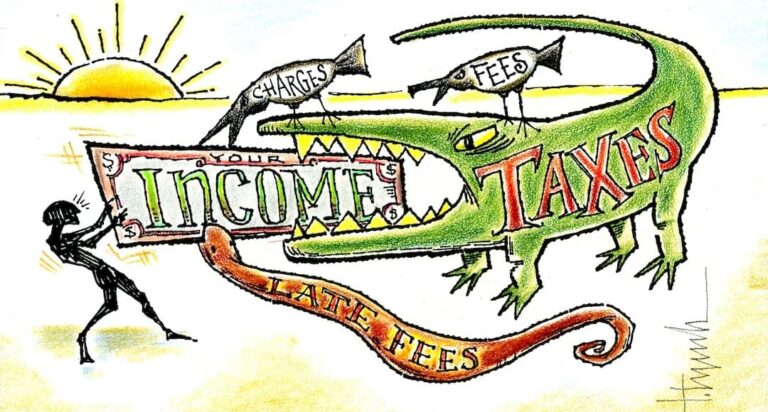
One of the most challenging financial questions you must eventually answer is, “How Much Money Do You Need to Retire Comfortably?” (i.e., to become financially independent). The answer may seem elusive because there are many factors, and everyone’s situation is unique. Yet you need a goal, even if retirement seems a long way off, because it will allow you to address issues and confidently make decisions. After all, as the great Yogi Berra famously said, “You’ve got to be careful if you don’t know where you’re going because you might not get there.”
Painting a clear image of your day-to-day lifestyle in retirement can be difficult, but fortunately, the math is relatively straightforward. In the following post, I provide insights, guidance, and a step-by-step process for working through this exercise.
Understanding Your Retirement Needs
Before we dive in, allow me to provide some context.
Retirement income planning is an ongoing process that starts when you get your first serious job and can contribute to a retirement plan, usually in your 20s. But no one expects you to know how much you need to retire when in your 20s. Your mission at that age is to establish good financial habits.
Most people are ready to consider this question in their late thirties or forties. At this point, your career is more settled, and you probably have a significant other and a vision for your desired lifestyle in retirement. For simplicity, I wrote this blog post assuming you are in this stage of life or older.
Coping With Uncertainty and Variety
Another thing to keep in mind is that each of you will have unique needs at the time you retire. For example, healthcare will be a big issue if you retire early. Those willing to wait until age 65, when Medicare eligibility begins, may not have that particular concern, but there will be other factors specific to your life (and plan). Therefore, you will need a personalized retirement plan to accommodate your unique circumstances.
That said, five truths about retirement income planning affect everyone.
- A couple that retires at age 62-65 must plan on 30 years in retirement.
In other words, at least one person is likely to live to 92-95. - The cost of living will likely double in 30 years.
A 2.4% average inflation rate would produce this result. - To keep up with the rising cost of living, you must continue growing your purchasing power.
The conventional wisdom that you retire, put all your money in the bank, and live off interest doesn’t work (and never has). The rate of return on CDs and savings accounts has not historically outpaced inflation rates. We have every reason to believe this trend will continue. - You must continue to own companies throughout retirement.
The great companies of the world have historically raised dividends at rates exceeding inflation. Bonds and other fixed-income instruments have not. We acquire ownership in companies through the stock market. - The stock market is volatile.
You must be mentally and financially prepared to tolerate significant drops in value to your portfolio. We model reductions in value of up to 40% every five years or so in our plans.
The first line of defense against such terrifying prospects is to expect them. That is the mental preparation we must do. The financial line of defense against such events is a large cash cushion. For example, we like to keep two years of expected withdrawals in cash so we can stop pulling funds from the portfolio and give it time to recover.
Please keep this information in mind as we move forward.

How to Calculate How Much Money You Need to Retire (The Math)
When establishing retirement savings goals, we recommend analyzing your expected income streams and expenses, then applying a rule-of-thumb approach to estimate the required size of your nest egg. That allows you to look at the problem from multiple angles and increases your confidence in the final number. To show you what this looks like in practice, let’s go through the math together, step by step.
Navigation
- Estimate your guaranteed retirement income (net of taxes).
- Estimate your retirement expenses.
- Calculate your pre-tax income gap.
- Apply a rule-of-thumb approach.
Step 1: Evaluate Your Guaranteed Retirement Income Streams

Take inventory of every guaranteed source of income you expect to have in retirement. These are funds that are independent of your retirement savings and expected to continue indefinitely. I realize this may change as your life unfolds, but for the sake of this exercise, work in today’s dollars and imagine you wish to retire shortly. For example, below are some guaranteed income sources you might draw upon.
- Social security benefits
- A pension
- An annuity
- Passive income from rental properties or royalties
Please understand that taxes can seriously impact these numbers, so it is vital to think that through. To keep this exercise simple, let’s focus on social security income.
The IRS taxes social security income differently from ordinary income. Most people can expect to pay taxes on 85% of their social security benefits, so for illustration, we will imagine this is true for you and apply a 12% annual tax rate. Here is the math:
- Review your Social Security statement to determine your anticipated pre-tax Social Security income. For this example, we assume you and your partner will receive $67,000 annually.
- Determine how much of that income is taxable.
Taxable Social Security Income = 85% x Pre-Tax Social Security Income
– OR –
$56,950 = 85% x $67,000
- Calculate your Social Security income taxes.
Social Security Income Taxes = Taxable Social Security Income x 12%
– OR –
$6,834 = $56,950 x 12%
- Determine your social security income net of taxes.
Social Security Income Net of Taxes = Pre-Tax Social Security Income – Taxes
– OR –
$60,166 = $67,000 – $6,834
Great! You and your partner expect to receive $60,166 from social security net of taxes. Let’s round that figure to $60,000, assume you have no other guaranteed income sources, and move on.
Navigation
Step 2: Estimate Your Retirement Expenses
Track your expenses today, then use that information to estimate what you will spend in retirement in today’s dollars. The more history you have, the better because it will give you a sense of your spending patterns. Although your situation will be unique, here are some everyday expenses you should capture.
- Mortgage or Rent
- Property tax
- Utilities
- Auto expenses
- Insurance premiums
- Medical costs
- Groceries & Dining
- Household expenses
- Home Improvement
- Personal care expenses
- Pet costs
- Travel & Entertainment
- Gifts
- Charity
If this feels overwhelming, just look at your annual credit card and bank account statements for an easy starting point. Most banks provide a yearly spending summary you can download into a PDF or spreadsheet.
Naturally, some costs will change as you grow older. For instance, if you own your home, you may eventually pay off your mortgage. And some families no longer need two cars. But your healthcare costs will also change, and you may spend more on entertainment, so reviewing every expense category and being honest with yourself is vital. Some people think they will spend less in retirement, but in our experience, this is rarely the case.
A side benefit of this exercise is that it encourages you to examine your spending. If you notice something amiss, seeing it in the context of how it will affect your retirement savings can motivate you to adjust.
For our purposes, let’s assume your expenses are $7,300 per month or $87,600 annually.
Navigation
Step 3: Determine Your Pre-Tax Income Gap

Once you arrive at a number for retirement expenses, increase it to account for taxes. If your entire nest egg is in a pre-tax 401k or traditional IRA, it will be fully subject to tax. Again, let’s assume a 12% annual tax rate. With $87,600 in yearly expenses, the math is as follows:
Pre-Tax Annual Income Requirement = Annual Expenses / .(100 – Tax Rate)
– OR –
$99,545 = 87,600 / .(100 – 12)
For simplicity, we will round up to $100,000.
Next, compare your expected guaranteed income from Step 1 to your anticipated expenses to determine your income gap. Again, the math is as follows:
Income Gap = Pre-Tax Annual Income Requirement – Guaranteed Income (Net of Taxes)
– OR –
$40,000 = $100,000 – $60,000
Now we know you need to save enough to cover a $40,000 income gap in your first year of retirement. How can we get to that final number – the required size of your nest egg?
Navigation
Step 4: Apply a Rule-of-Thumb Approach, Like the 4% Rule
The 4% rule assumes you will build a nest egg large enough to cover the gap in your income if you withdraw 4% of the total in year one, then increase that amount each year for inflation. Many financial professionals (including me) like this rule because, although it’s not perfect, it is a straightforward way to determine your goal while being reasonably confident that your money will last.
To calculate how much money you need to retire using the 4% rule, you must first go through steps 1-3 above to assess your income gap. Then, divide your income gap by 4% to determine your retirement goal. Here is the math:
Retirement Savings Goal = Income Gap / 4%
– OR –
$1MM = $40,000 / 4%
Sometimes, experts flip this math around to state that your nest egg should be 25 times your desired salary at retirement age. That can be confusing, but remember, it’s all about addressing your income gap. $40,000 x 25 = $1MM. In other words, it’s the 4% rule, stated differently.
And, don’t forget, we like to see two years of expected withdrawals in cash, so in this case, you would aim to save $1MM + (2 x $40,000), or $1,080,000.
Navigation
Setting Goals and Choosing Strategies
Once you arrive at a number, you will likely feel more settled. After all, it is fantastic to know what you are aiming for. But you may also have more questions. For instance:
- Do your calculations honestly answer the question, “How much money do you need to retire comfortably,” or do you need a larger cushion for peace of mind?
- Are you properly accounting for taxes, or are there things you could do to minimize your tax burden so your money will last longer?
- Will you satisfy the Requirement Minimum Distribution (RMD) requirement If you only take 4% from your retirement accounts?
- Will your RMD increase your taxable income enough to cause Medicare surcharges?
- Is planning for long-term care prudent?
These questions are a natural outcome of this process, and that’s okay because setting a goal is just one piece of retirement income planning. Now that you have this knowledge, you can iterate. For instance, if the number you arrived at seems entirely out of reach, you might rework the numbers to develop more realistic goals. But there is no magic bullet here – you can change three simple factors to impact the numbers.
- Work longer.
- Save more.
- Spend less in retirement.
Only you can determine what is acceptable.
If you want to play with the numbers to gain more insight into your trajectory, consider using a financial model to see how your income and expenses could evolve due to compounding and inflation. It is also wise to test scenarios such as the possible influx of cash or a reduction in your savings. If you have the skills, you can build a model using a spreadsheet or with the help of online retirement calculators, but many people prefer to consult a financial advisor.
The Role of a Professional Financial Advisor

When you have reached the limits of what you can do yourself, a financial advisor can pick up the slack and offer some much-needed expertise. Choose someone reputable and trustworthy with training in personal finance, such as a CFPⓇ practitioner. The right advisor will walk you through the process above, help you build a holistic and personalized financial plan, and suggest appropriate strategies for your situation.
For example, in addition to encouraging you to save for retirement, they will ensure that you make the most of employer matching, manage your debt correctly, and explore tax planning strategies like IRA conversions or Backdoor Roth IRAs.
Then, once you are on track, you will have regular check-ins to make adjustments. As retirement grows closer, they will help you develop a tax-efficient withdrawal strategy and a plan for managing healthcare expenses. They will serve as your financial partner, keeping you on course during times of volatility while providing direction for how and when to use your emergency fund and how to develop a savings plan to replenish it when you do.
How Much Money Do You Need to Retire: The Bottom Line
Determining how much money you need to retire is relatively straightforward:
- Estimate your guaranteed retirement income (net of taxes).
- Estimate your retirement expenses.
- Adjust your expenses to determine your pre-tax annual income requirement. Then, calculate the difference between your income requirement and your guaranteed income. That is the income gap you must cover with savings.
- Apply the 4% rule to calculate how big your nest egg should be to fill the income gap.
Perform these calculations in today’s dollars. We know the figures will increase, but your income and savings will also grow, and we will continue to iterate.
This approach gives us a sensible ballpark figure to start from. The tricky part is figuring out what to do next. A good financial advisor can help you answer that question, so we encourage you to reach out to discuss your unique situation.

Author
-

Kevin Caldwell is a principal at Golden Road Advisors and a CERTIFIED FINANCIAL PLANNER™ (CFP®️) practitioner with over 15 years of experience in the financial services industry. In addition to providing advice and guidance to clients, he regularly contributes to publications such as Kiplinger, Yahoo! Finance, Dalbar, and MarketWatch.
View all posts



